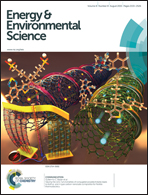Structure of the high voltage phase of layered P2-Na2/3−z[Mn1/2Fe1/2]O2 and the positive effect of Ni substitution on its stability†
Abstract
A combination of operando X-ray diffraction, pair distribution function (PDF) analysis coupled with electrochemical measurements and Mössbauer spectroscopy elucidates the nature of the phase transitions induced by insertion and extraction of sodium ions in P2-Na0.67[NiyMn0.5+yFe0.5−2y]O2 (y = 0, 0.10, 0.15). When phase transitions are avoided, the optimal cathode material – P2-Na0.67Fe0.2Mn0.65Ni0.15O2 – delivers 25% more energy than the unsubstituted material, sustaining high specific energy (350 Wh kg−1) at moderate rates and maintains 80% of the original energy density after 150 cycles – a significant improvement in performance vs. the unsubstituted analogue. The crystal structure of the high voltage phase is solved for the first time by X-ray PDF analysis of P2-Na0.67−zFe0.5Mn0.5O2 (where z ∼ 0.5), revealing that migration of the transition metals – particularly Fe3+ – into tetrahedral sites in the interlayer space occurs at high potential. This results in new short range order between two adjacent layers. Although the transition metal migration is reversible as proven by electrochemical performance, it induces a large disfavourable cell polarization. The deleterious high voltage transition is mitigated by substitution of Fe3+ by Mn4+/Ni2+, giving rise to better cycling performance. Moreover, as demonstrated by 57Fe Mössbauer spectroscopy, the much lower ratio of Fe4+O6 to Fe3+O6 observed systematically across the range of Ni content – compared to the values expected from a purely ionic model – suggests redox activity involves the O-2p orbitals owing to their overlap with the transition metal-3d orbitals.
![Graphical abstract: Structure of the high voltage phase of layered P2-Na2/3−z[Mn1/2Fe1/2]O2 and the positive effect of Ni substitution on its stability](/en/Image/Get?imageInfo.ImageType=GA&imageInfo.ImageIdentifier.ManuscriptID=C5EE01365H&imageInfo.ImageIdentifier.Year=2015)

 Please wait while we load your content...
Please wait while we load your content...